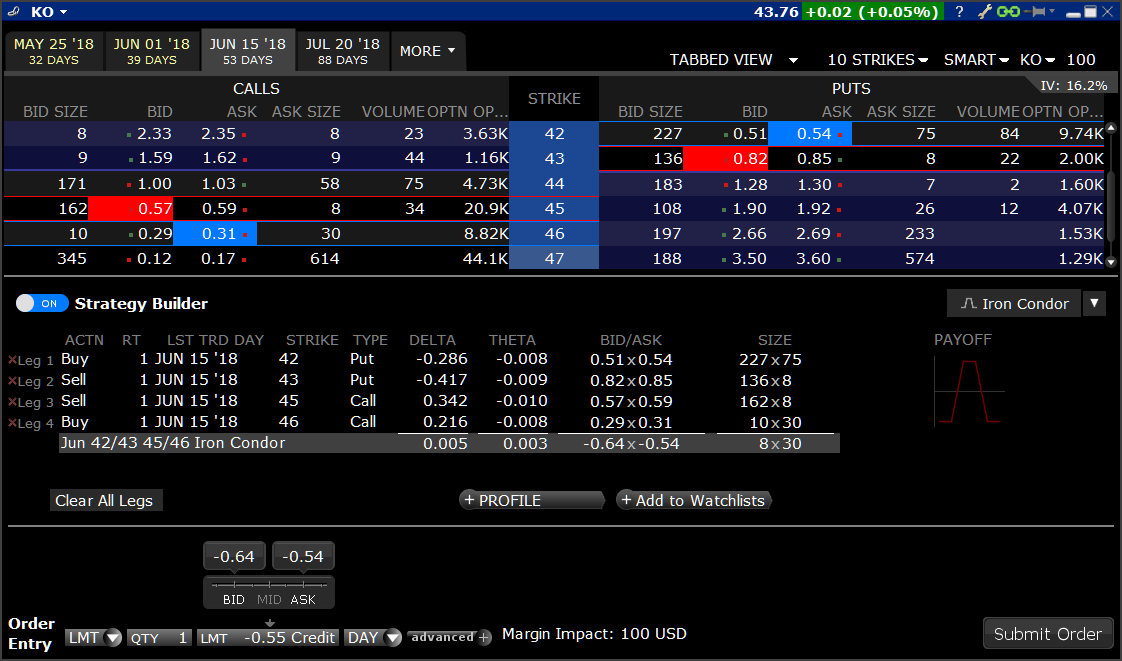***newbie alert***
I decided to try 1x Iron Butterfly because:
- large initial credit
- curious what is the final credit (will know on Friday close)
5/28 +p575/-p600/-c600/+c650, credit $2k, margin $720, max loss $2900, breakeven 579/620
By my math your margin is $2.5k on the low side + $5k on the high side (since IIRC your broker doesn't let you double dip margin), and potentially minus the $2k credit you received (that's not how American brokers typically work but I dunno about Canadia) for a total of maybe $5.5k. Am I missing something?
In any event...Its definitely a good idea to open an IB with a wide spread on the longs, kinda like you have (Especially your ~10% width on the call side). The longs are what control the slope of the butterfly's 'body', and following the area-under-the-curve profit logic from upthread somewhere, the P/L of a wide body sacrifices peak profit for a wider break even range. Conversely, If you were building an inverse IB you might want a narrower spread on the longs, making max loss worse but bringing in your break even points.
Yours is also an asymmetric butterfly, with more risk on the upside than the downside, and it also happens to be a specific instance called a skip strike iron butterfly. If that asymmetry was on purpose, you may also want to consider asymmetric evolutions like the Christmas tree and ratio spreads (sometimes called front or back spreads) for really tailoring P/L (including inverse instances of those strategies).
Note that you can also do 'regular' condors and butterflies (= all calls or all puts) which sometimes actually nets you a better premium than the irons because of the slight variances in prices on either side of the options chain. In some cases they may also reduce the margin requirement of the position because one side of the position actually is a debit spread (so potentially no margin required, just initial capital). You can even take this concept one step farther and make both sides debit spreads (so, puts on the top and calls on the bottom) landing you in zero-margin land for the whole position...though its possible the pretty high price of that ticket might end up equaling the margin requirements of the 'traditional' IB anyway. Just doing a quick run through the options chain your IB with the same strikes just inverted calls and puts would cost you ~$5600.
I've contemplated a number of recurring strategies in my struggles to find the holy grail of selling options, and one of the ones that resonates the most starts with a butterfly. Basically, you sell the weekly butterfly (or IB) and then you take however long you need to take to close it via the flip/split methodology. In that concept you max your time value (and thus your sale of volatility) on the initial IB, and then it just takes you N number of weeks to fully realize that profit. Sometimes you get lucky and N=1, sometimes it could take weeks or even months. Then you just start over with the next IB. Annually that is near guaranteed profit on a fixed amount of capital; the variable is simply how much profit.
Since I'm chatty again, you'll probably evolve to my fave multi-leg ticket, the double calendar. It is any of the above mentioned multi-leg strategies, just with farther expirations on the longs. It can be really effective at catching agnostic directional movement, especially if you can close out the 'losing' long leg early.
Of course, bow tying all of this together, at some point you'll realize that any kind of recurring options selling strategy still requires pretty mature price and volatility analysis to actually play out in the long run (so, more than just TSLA 2020) and then you'll realize that its far less work and far more profitable to simply wait for your analysis to identify strong entry positions rather than stress out staring at stonk prices all day long in an effort to scrape out peanuts in profit by selling recurring short positions.
Mind, sometimes we get bored and can't help ourselves. Friday my only position in this account was the TSLA CC. I ran my quick volatility scanner yesterday and, combined with a basic price analysis, opened up a *sugar* ton of ICs.




